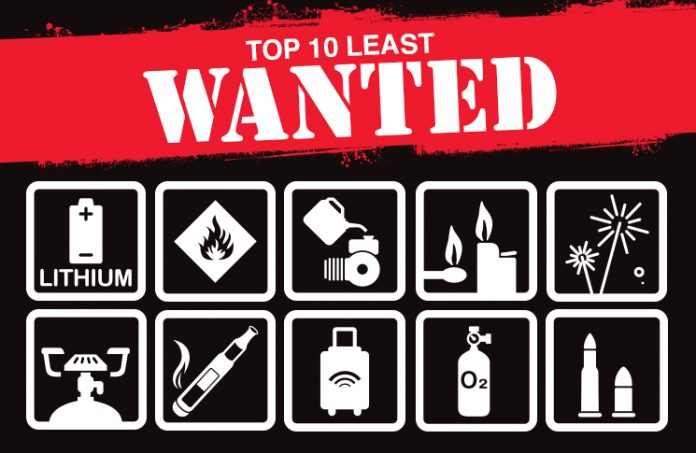For the fourth year running, lithium batteries, found in smartphones and tablets, have been named as the most problematic item carried by passengers in Australian skies in 2018. Lithium batteries are used to charge most of our portable electronic devices, but they can have serious safety consequences if they are not carried correctly while you are flying. There have been several incidents of lithium batteries igniting causing a number of mid-air emergencies.
The ‘least wanted’ dangerous goods list, released annually by CASA, highlights the top ten most dangerous goods air travellers pack in their luggage and carry on board domestic flights. In 2018 these were:
- Lithium batteries
- Flammable and non-flammable gas canisters and cylinders
- Items such as chainsaws and whipper snippers with internal combustion engines
- Lighters, lighter refills and matches
- Sparklers
- Camping stoves with fuel
- E-cigarettes
- Smart bags
- Passenger portable oxygen cylinders without clearance from the airline
- Ammunition
Passengers packing these items into their luggage remain a constant threat to aviation safety despite widespread warning. With batteries, all spare batteries not contained within equipment must be in carry-on luggage with their terminal protected.
E-cigarettes made the list for the first time in 2018. They must be in your carrying-on baggage and not in your checked luggage. The battery inside can explode if accidentally activated.
Smart bags first made the list in 2017. With non-removable batteries, they are now banned by many airlines around the world including Qantas, Virgin Australia and several US carriers. Smart suitcases, which can charge mobile phones, weigh themselves, be tracked by GPS and act as a transport device for the weary traveller, are powdered by lithium batteries and are a fire risk when packed in cargo holds. They can only be used if the battery can be removed from the bag and packed into carry-on luggage.
CASA has produced a ‘Can I pack that’ dangerous goods app that advises passengers on what they can and cannot pack into their luggage. It tells you if an item can be packed in your checked-in luggage, carry-on luggage or if you need prior permission from the airline to carry it.



I totally agree with your point, when you say “Passengers packing these items into their luggage remain a constant threat to aviation safety despite widespread warning.
I wrote this article about understanding IATA Dangerous Goods Table – 2.3.A.
I hope you read it, besides this amazing article.
Thank you again.